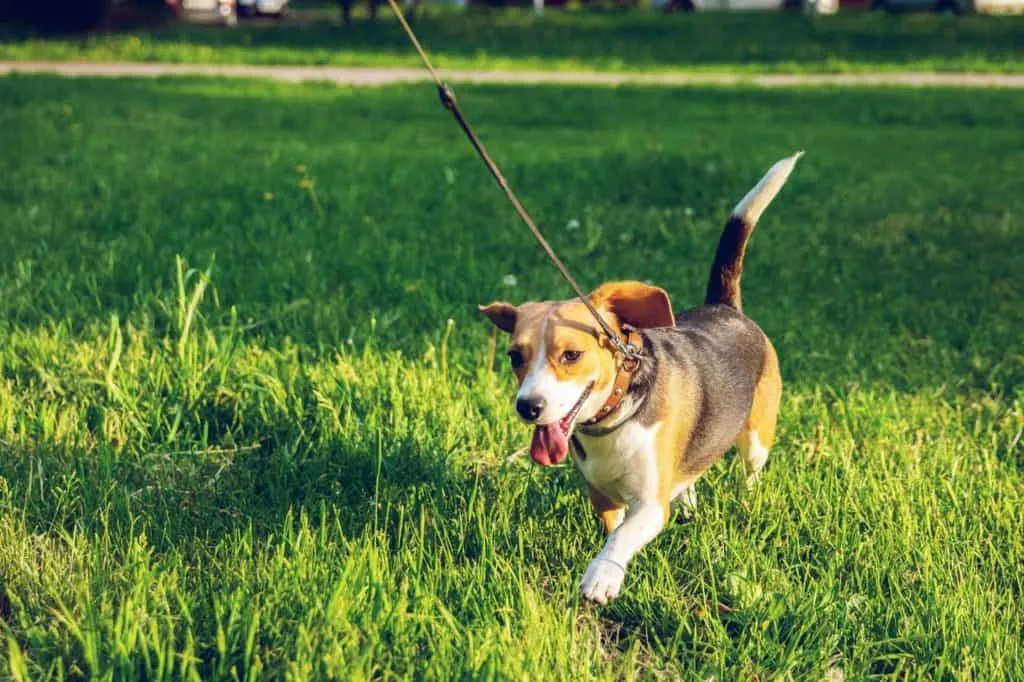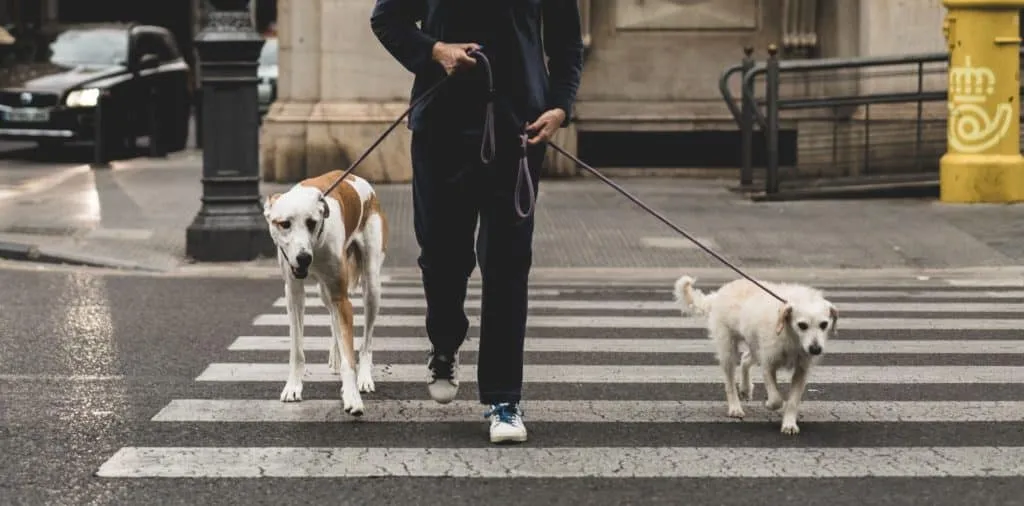Walking a young puppy on a leash can be challenging at first. Leash training a puppy is important as there will be times when your puppy doesn’t want to walk.
Taking your puppy on a regular walk outside is an essential part of puppy training and in keeping a happy and healthy dog. Not only do walks together provide great exercise for both you and your small pup. In addition, they allow you to bond with your furry friend.

FLEXI New Classic Cord Retractable Dog Leash for Small Dogs up to 33 lbs. – 26 ft., Black | Tangle-Free Pet Walking Leash with One-Handed Brake, Pause, Lock|German Quality Product
View on Amazon
PetSafe Clik-R Dog Training Clicker - Positive Behavior Reinforcer for Pets - All Ages, Puppy and Adult Dogs - Use to Reward and Train - Training Guide Included - Purple
View on Amazon
Blueberry Pet Essentials Matching Large Dog Collar | Adjustable Classic Solid Color Nylon Dog Collars for Large Dogs | Reflective Dark Olive Dog Collar for Large Dogs
View on Amazon
EcoBark Step in Dog Harness - Eco-Friendly Teacup Dog Harnesses for XXS, XS, and Small Dogs - Reflective and Adjustable Mini Body Halter Vest -Tiny Soft Mesh Toy Breed Harness Under 5 lbs (Pink, XXS)
View on AmazonWhat is Leash Training?
Many people think puppies instinctively know how to walk on a leash, but that isn’t the case. Too many issues come up like your puppy refuses to walk, a puppy bites the leash, a puppy chews on the leash, and so on.
Some young pups may even be a bit fearful of putting on a collar, harness, or leash when you first try to walk them. But don’t let all of these bring you down.
What age should you start leash training a puppy?
As part of their socialization and developmental training, be sure to start to leash train a puppy as soon as they can walk outdoors. But before doing that, it is essential to understand first how to slowly introduce the concept of a collar and leash. Get your dog to capture the idea of walking on a leash.
Puppies must be trained to walk on a leash. Leash train your new puppy early and lead him to establish good walking habits. And it is not just teaching them that but also teaching them to observe good behavior, especially in public.
Steps on how to Train your Puppy to Walk on a Leash
Step 1: The first step to training your pup to walk on a leash is to get them familiar with their leash and collar (or harness). The first time your puppy sees the leash, allow him to sniff it before using it for a walk. Give him time to get used to seeing it around him.
Do not let your furry one begin to bite and play with the leash. That way, your furry pets will understand that their leashes are not toys.

Step 2: Start puppy training inside the home by putting the leash and harness or collar on your pup and rewarding them with a treat. Keep the harness or collar and the leash on them for a while. Allow them to get used to the feel of wearing them.
Lead your puppy and practice walking around the home with your puppy on a leash for short periods. Stop the practice or let them rest when your dogs start getting restless and pulling on on the leash or when they are no longer attentive to the training process.
Adjust the time walking around the home a little bit longer day by day. Again, stop when your puppy pulls on the leash or keeps trying to take it off. Take him to the next step of his training when you see your dog is more used to it and comfortable doing this.
Step 3: It’s time to move and walk outside with your furry little one. Before going out of your home, ensure that the collar (or harness) and the leash are attached properly and securely.
To leash train your puppy could be one of the easiest tasks in training your new pet.
Taking a Walk
Getting your puppy outside with a collar and leash may go rather smoothly. Once your dogs are outside, they will be exposed to new sights, smells, and noises. Often, this is when things get a bit more challenging.
Using a verbal cue followed by some puppy training treats is a good way to leash train your puppy to focus more on you rather than paying attention to the new distractions.
Keep your puppy right by your side and move forward.
If your pup sees something new or exciting such as a squirrel, other dogs, or a neighbor, he will most likely leave your side and move towards them. Right at that moment, call your dog back to you and reward them with a treat.
The goal here is to get your pup to obey you, regardless of what is going on around them. This will, as well, form part of their dog obedience training.
The first several walks with your new puppy should be short. This will allow you and your dogs to practice using a verbal cue. Using the verbal cue, followed right away by yummy treats, should help your pup want to stay close to you.
You might have noticed that in dog competitions, people have their dogs walk to their left side and wondered if you should do the same with your puppy.
It doesn’t really matter what side you get your furry pets to walk on, as long as you keep things consistent every time you take your pups on a walk.

Manners Matter
When your puppy takes their first walks on the leash, many scenarios are possible. There would be moments when your dog would have the leash around his body for too much moving.
Too many distractions would take their attention that would cause them to pull, lunge, or bark. These common behaviors seem manageable and even cute at this stage of your dog’s life.
As your puppy grows, these behaviors can make walks almost impossible. Thus, at the very start, you need to practice good manners with your dogs and teach them the right behavior.
If Your Puppy is pulling…
Should I pull my puppy on a leash? How do you train a puppy to walk on a leash without pulling?
When your dog pulls on the leash, it feels natural to yank them back closer to you. But this is not advised. Rather, the moment they started pulling, stop walking and stand in one place.
Stay in that position even if your dog is a few steps away from you. You need to wait until your pup comes back on his own. When they do, give them treats and verbal praises. Complete this process each time the puppy pulls while on the leash.
If Your Puppy is Barking…
Your puppy may be barking on the leash at other things like another dog, people, bicycles, or squirrels. Observe what it is that is getting his attention and is causing your pup to bark. Along with barking, your dog will sometimes pull on his leash as well.
The key to curbing this behavior is anticipating your puppy’s actions. If you know your dog will bark at a passing dog, you need to create as much distance as possible. Then, call your dog to you before they see the trigger and reward them when they obey.
This will teach your dogs to ignore things that may cause them to bark initially, and it will teach them to stop barking. Over time, they will get used to these scenes and will not let them be a distraction.
If Your Puppy is Lunging…
Excitement or fear may be causing your new puppy to lunge or jump at people or other living things. This often happens for puppies who pull on the leash as well. This is because they are not used to or unfamiliar with seeing these things.
Just as with barking, you want to create as much distance as possible from the object your pup is lunging towards. Call your puppy towards you when you see something that may cause them to lunge.
Reward your pup each time they respond to this as part of training them not to jump or lunge at something.
Positive Reinforcement
One key step to helping your puppy learn good walking etiquette is bringing treats with you on your walks. Using treats to reinforce positive walking behaviors will help your puppy learn what you expect quickly.
Over time, you can give fewer treats. Through positive reinforcement, your pup will learn what is expected, knowing they will get a reward at times for their efforts.
Be sure that when you give your dog a treat for desired behavior, they are not jumping on you to get that treat. Kneel to give your pup their treat. You may even command the dog to sit before receiving the treats for positive leash behavior.
Some dog owners also prefer to practice with a dog training clicker . You can buy one of these small handheld devices that creates a clicking sound that can be made right before you give your puppy a treat.
Once you begin to give them fewer treats to reinforce good leash walking, you may continue to use the clicker. Your pup will associate the clicking noise with the treat and know that their behavior is good.
Walking Gear
You can purchase a dog collar from almost anywhere. They sell simple collars at local retailers such as Target, Wal-Mart, and even Dollar Tree. However, make sure to choose a collar that will be comfortable and safe for your dog.
You should also select a collar that can withstand the energy of your puppy, such as the Blueberry Pet Essentials Personalized Collar or this Country Brook Petz nylon dog collar .
When selecting a collar for your young pup, you want to make sure to choose the proper size. Most collars are adjustable and will accommodate your puppy as they grow. However, if the collar is too tight, you want to buy a larger size.
You may want to consider buying a harness if your puppy is prone to pulling or lunging while on the leash. This will help make the training a bit easier for you.
There are many different styles of harness you can choose from. Be sure to consider your preference for getting your puppy into the harness. The harness should be safe and comfortable for your pup.
Local pet stores such as Petsmart and Petco carry a variety of harnesses as well as online retailers such as Amazon.com. The EcoBark harness is a reasonably priced option that also has reflective fabric.
When you choose a leash to train your little puppy to walk, pick a leash that feels comfortable to you. You want to have a leash that can keep your young pup rather close while you are working on training leash behaviors.
You may want to use a retractable leash for leash training when you are in your yard or controlled space. This will also let you keep the leash short to prevent getting the leash around your dog’s body.
Summary
Leash training your puppy is an essential part of puppy and dog training and in keeping your furry one happy and healthy**.** Be sure to use positive reinforcement during leash training to help your dog learn what desired leash behavior looks like.
Start small and work your way up to walk nicely with your pup. Start to leash train your puppy, and don’t forget to enjoy the fresh air and bonding with your puppy!